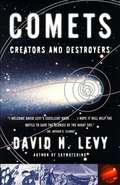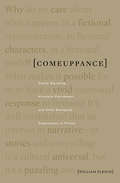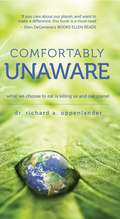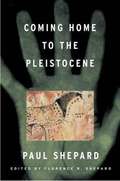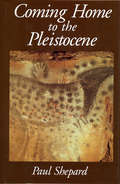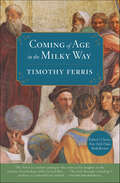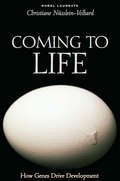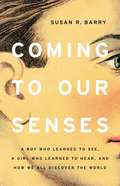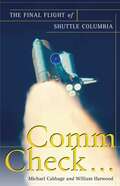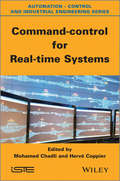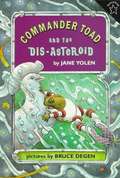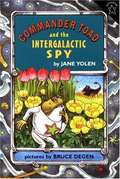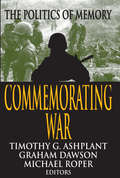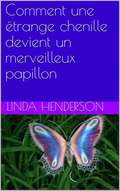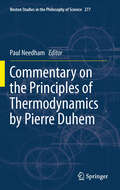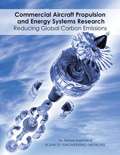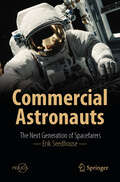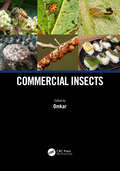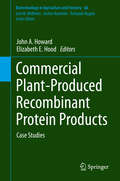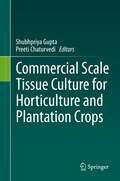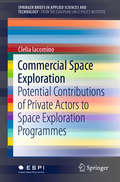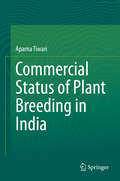- Table View
- List View
Comets: Creators And Destroyers
by David H. LevySpectacular and mysterious objects that come and go in the night sky, comets have dwelt in our popular culture for untold ages. As remnants from the formation of the Solar System, they are objects of key scientific research and space missions. As one of nature's most potent and dramatic dangers, they pose a threat to our safety - and yet they were the origin of our oceans and perhaps even life itself. This beautifully illustrated book tells the story of the biggest and most awe-inspiring of all comets: those that have earned the title 'Great'. It focuses on Great Comets Hyakutake in 1996 and Hale-Bopp in 1997, which gripped attention world-wide because, for many, they were the first comets ever seen. For everyone interested in astronomy, this exciting book reveals the secrets of the Great Comets and provides essential tools for keeping up-to-date with comet discoveries in the future.
Comets: Creators and Destroyers
by David H. LevyDavid Levy brings these "ghostly apparitions" to life. With fascinating scenarios both real and imagined, he shows how comets have wreaked their special havoc on Earth and other planets. Beginning with ground zero as comets take form, we track the paths their icy, rocky masses take around our universe and investigate the enormous potential that future comets have to directly affect the way we live on this planet and what we might find as we travel to other planets. In this extraordinary volume, David Levy shines his expert light on a subject that has long captivated our imaginations and fears, and demonstrates the need for our continued and rapt attention.
Comets: The Quest to Solve a Space Mystery (Fountas & Pinnell Classroom, Guided Reading Grade 5)
by Elizabeth Rusch Isabelle RuschMYSTERIOUS VISITORS They hang in the sky for weeks and then disappear. They're bright like stars, but they have tails. What are they? And where do they come from? Even after hundreds of years of study, we're still tracking down answers. NIMAC-sourced textbook
Comeuppance: Costly Signaling, Altruistic Punishment, and Other Biological Components of Fiction
by William FleschWith Comeuppance, William Flesch delivers the freshest, most generous thinking about the novel since Walter Benjamin wrote on the storyteller and Wayne C. Booth on the rhetoric of fiction. In clear and engaging prose, Flesch integrates evolutionary psychology into literary studies, creating a new theory of fiction in which form and content flawlessly intermesh. Fiction, Flesch contends, gives us our most powerful way of making sense of the social world. Comeuppance begins with an exploration of the appeal of gossip and ends with an account of how we can think about characters and care about them as much as about persons we know to be real. We praise a storyteller who contrives a happy or at least an appropriate ending, and fault the writer who refuses us one. Flesch uses Darwinian theory to show how fiction satisfies our desire to see the good vindicated and the wicked get their comeuppance. He conveys the danger and excitement of reading fiction with nimble intelligence and provides wide reference to stories both familiar and little known. Flesch has given us a book that is sure to claim a central place in the discussion of literature and the humanities.
Comfortably Unaware: What We Choose To Eat Is Killing Us And Our Planet
by Richard OppenlanderIn Comfortably Unaware, Dr. Richard Oppenlander tackles the crucial issue of global depletion as it relates to food choice. We should all be committed, he tells us, to understanding the reality and consequences of our diet, the footprint it makes on our environment, and seek food products that are in the best interest of all living things. His forthright information and stark mental images are often disturbing-and that's how it should be. As the guardians of Planet Earth, we need to be shaken out of our complacency, to stop being comfortably unaware, and to understand the measures we must take to ensure the health and well-being of our planet-and of ourselves. Oppenlander
Coming Home to the Pleistocene
by Paul Shepard Florence R. Shepard"When we grasp fully that the best expressions of our humanity were not invented by civilization but by cultures that preceded it, that the natural world is not only a set of constraints but of contexts within which we can more fully realize our dreams, we will be on the way to a long overdue reconciliation between opposites which are of our own making." --from Coming Home to the Pleistocene. Paul Shepard was one of the most profound and original thinkers of our time. Throughout his long and distinguished career, Paul Shepard returned repeatedly to his guiding theme, the central tenet of his thought: that our essential human nature is a product of our genetic heritage, formed through thousands of years of evolution during the Pleistocene epoch, and that the current subversion of that Pleistocene heritage lies at the heart of today's ecological and social ills. Coming Home to the Pleistocene provides the fullest explanation of that theme. Completed just before his death in the summer of 1996, it represents the culmination of Paul Shepard's life work and constitutes the clearest, most accessible expression of his ideas. Coming Home to the Pleistocene pulls together the threads of his vision, considers new research and thinking that expands his own ideas, and integrates material within a new matrix of scientific thought that both enriches his original insights and allows them to be considered in a broader context of current intellectual controversies. In addition, the book explicitly addresses the fundamental question raised by Paul Shepard's work: What can we do to recreate a life more in tune with our genetic roots? In this book, Paul Shepard presents concrete suggestions for fostering the kinds of ecological settings and cultural practices that are optimal for human health and well-being. Coming Home to the Pleistocene is a valuable book for those familiar with the life and work of Paul Shepard, as well as for new readers seeking an accessible introduction to and overview of his thought.
Coming Home to the Pleistocene
by Paul Shepard Florence R. ShepardPaul Shepard was one of the most profound and original thinkers of our time. Seminal works like The Tender Carnivore and the Sacred Game, Thinking Animals, and Nature and Madness introduced readers to new and provocative ideas about humanity and its relationship to the natural world. Throughout his long and distinguished career, Paul Shepard returned repeatedly to his guiding theme, the central tenet of his thought: that our essential human nature is a product of our genetic heritage, formed through thousands of years of evolution during the Pleistocene epoch, and that the current subversion of that Pleistocene heritage lies at the heart of today's ecological and social ills.Coming Home to the Pleistocene provides the fullest explanation of that theme. Completed just before his death in the summer of 1996, it represents the culmination of Paul Shepard's life work and constitutes the clearest, most accessible expression of his ideas. Coming Home to the Pleistocene pulls together the threads of his vision, considers new research and thinking that expands his own ideas, and integrates material within a new matrix of scientific thought that both enriches his original insights and allows them to be considered in a broader context of current intellectual controversies. In addition, the book explicitly addresses the fundamental question raised by Paul Shepard's work: What can we do to recreate a life more in tune with our genetic roots? In this book, Paul Shepard presents concrete suggestions for fostering the kinds of ecological settings and cultural practices that are optimal for human health and well-being.Coming Home to the Pleistocene is a valuable book for those familiar with the life and work of Paul Shepard, as well as for new readers seeking an accessible introduction to and overview of his thought.
Coming of Age in the Milky Way
by Timothy FerrisAn eloquent and accessible journey through our evolving notions of the cosmos from “the best science writer of his generation” (Washington Post).From the second-century celestial models of Ptolemy to modern-day research institutes and quantum theory, our perception of the universe—and out place in it—has changed drastically. This classic book offers a breathtaking tour of astronomy and the brilliant, eccentric personalities who have shaped it through the ages. From the first time mankind had an inkling of the vast space that surrounds us, those who study the universe have had to struggle against political and religious preconceptions. They have included some of the most charismatic, courageous, and idiosyncratic thinkers of all time. In Coming of Age in the Milky Way, Timothy Ferris uses his unique blend of rigorous research and captivating narrative skill to draw us into the lives and minds of these extraordinary figures, creating a landmark work of scientific history.
Coming to Life: How Genes Drive Development
by Christiane Nusslein-VolhardChristiane Nusslein-Volhard, winner of The Nobel Prize in Medicine, gives a concise and illustrative overview of genetics, evolution, and cellular processes as well as a discussing of current ethical issues in human biology. Coming to Life is a remarkable journey through developmental biology that reveals miraculous processes in the microscopic world of cells. Through an accounting of groundbreaking discoveries, Christiane Nusslein-Volhard tells us many answers to historical and contemporary questions in science. For example, she brings us the newest knowledge about embryonic forms, explains the genetic mechanisms that influence adult development of all animals, and shares insights into the ethical standards society moist uphold in the face of new scientific discoveries. As the author leads us from laboratory research to its applications in human beings, we also come to understand why children look like their parents, how an embryonic cell knows to become an eye rather than an eyelash, and other incredible influences hat result in variety in life. Complete with her own hand-drawn illustrations, Coming to Life gives a rare opportunity to understand a Nobel Prize-winner's passion for science in concise, understandable language. 55 b/w illustrations.
Coming to Our Senses: A Boy Who Learned to See, a Girl Who Learned to Hear, and How We All Discover the World
by Susan R. BarryA neurobiologist reexamines the personal nature of perception in this groundbreaking guide to a new model for our senses.We think of perception as a passive, mechanical process, as if our eyes are cameras and our ears microphones. But as neurobiologist Susan R. Barry argues, perception is a deeply personal act. Our environments, our relationships, and our actions shape and reshape our senses throughout our lives.This idea is no more apparent than in the cases of people who gain senses as adults. Barry tells the stories of Liam McCoy, practically blind from birth, and Zohra Damji, born deaf, in the decade following surgeries that restored their senses. As Liam and Zohra learned entirely new ways of being, Barry discovered an entirely new model of the nature of perception. Coming to Our Senses is a celebration of human resilience and a powerful reminder that, before you can really understand other people, you must first recognize that their worlds are fundamentally different from your own.
Comm Check … The Final Flight of Shuttle Columbia: The Final Flight of Shuttle Columbia
by Michael Cabbage William HarwoodOn February 1, 2003, the unthinkable happened. The space shuttle Columbia disintegrated 37 miles above Texas, seven brave astronauts were killed and America's space program, always an eyeblink from disaster, suffered its second catastrophic in-flight failure. Unlike the Challenger disaster 17 years earlier, Columbia's destruction left the nation one failure away from the potential abandonment of human space exploration. Media coverage in the immediate aftermath focused on the possible cause of the disaster, and on the nation's grief. But the full human story, and the shocking details of NASA's crucial mistakes, have never been told -- until now. Based on dozens of exclusive interviews, never-before-published documents and recordings of key meetings obtained by the authors,Comm Checktakes the reader inside the conference rooms and offices where NASA's best and brightest managed the nation's multi-billion-dollar shuttle program -- and where they failed to recognize the signs of an impending disaster. It is the story of a space program pushed to the brink of failure by relentless political pressure, shrinking budgets and flawed decision making. The independent investigation into the disaster uncovered why Columbia broke apart in the sky above Texas. Comm Checkbrings that story to life with the human drama behind the tragedy. Michael Cabbage and William Harwood, two of America's most respected space journalists, are veterans of all but a handful of NASA's 113 shuttle missions. Tapping a network of sources and bringing a combined three decades of experience to bear, the authors provide a rare glimpse into NASA's inner circles, chronicling the agency's most devastating failure and the challenges that face NASA as it struggles to return America to space.
Command-control for Real-time Systems
by Mohamed Chadli Hervé CoppierA real-time system is a complex system which is an integral part of an industrial or experimental system, a vehicle or a construction machine. The peculiarity of these systems is that they are driven by real-time targets in distributed environments. Command-control for Real-time Systems presents the calculation of correction for industrial systems of different physical natures, their implementation on real-time target industrial systems (PLC-SCADA, embedded systems with distributed networks, Networked Control Systems) and their validation by simulation. It optimizes industrial processes by the use of automatic tools, industrial computing and communications networks and aims to successively integrate new control laws (linear, nonlinear and fuzzy controllers) so that users can leverage the power of engineering science as an automatic service process optimization while maintaining their high maintainability facilities. Contents 1. Introduction. 2. Modeling Tools, Sébastien Cabaret and Mohammed Chadli. 3. Control Tools, Mohammed Chadli and Hervé Coppier. 4. Application to Cryogenic Systems, Marco Pezzetti, Hervé Coppier and Mohammed Chadli. 5. Applications to a Thermal System and to Gas Systems, Sébastien Cabaret and Hervé Coppier. 6. Application to Vehicles, Elie Kafrouni and Mohammed Chadli. 7. Real-time Implementation, Marco Pezzetti and Hervé Coppier. About the Authors Mohamed Chadli is a senior lecturer and research supervisor at the University of Picardie Jules Verne (UPJV) in France. His main research interests lie in robust control, the diagnosis and fault tolerant control of polytopic systems and applications for automobiles. He is a senior member of the IEEE, and Vice President of the AAI Club as part of SEE-France. He is the author/co-author of 3 books, book chapters and more than 100 articles published in international journals and conferences. Hervé Coppier is a lecturing researcher at ESIEE-Amiens in France. He has collaborated with industrialists in the field of automation and industrial computing, particularly with CERN, and has spearheaded various international European projects.
Commander Toad and the Dis-asteroid (Commander Toad #4)
by Jane YolenYoung fans of Star Wars and silliness will toad-ally love Commander Toad! When Commander Toad and the crew of the Star Warts learn that a disaster has struck an asteroid, they race across the galaxy to the rescue. But it's hard to figure out just what is wrong, especially when there is a language barrier between the Star Warts' crew and the pigeon inhabitants of the dis-asteroid. A hero is needed, but is even intrepid Commander Toad brave enough to save the day?
Commander Toad and the Intergalactic Spy (Commander Toad #5)
by Jane YolenCommander Toad and the crew of Star Warts are asked to rout out Tip Toad, Space Fleet's greatest and most elusive spy.
Commemorating War: The Politics of Memory
by Graham Dawson Timothy G. Ash PlantWar memory and commemoration have had increasingly high profiles in public and academic debates in recent years. This volume examines some of the social changes that have led to this development, among them the passing of the two world wars from survivor into cultural memory. Focusing on the politics of war memory and commemoration, the book illuminates the struggle to install particular memories at the center of a cultural world, and offers an extensive argument about how the politics of commemoration practices should be understood.Commemorating War analyzes a range of forms of remembrance, from public commemorations orchestrated by nation-states to personal testimonies of war survivors; and from cultural memories of war represented in films, plays and novels to investigations of wartime atrocities in courts of human rights. It presents a wide range of international case studies, encompassing lesser-known national histories and wars beyond the well-trodden terrain of Vietnam and the two world wars in Europe.Emerging from this book is an important critique of both "state-centered" approaches to war memory and those that regard commemoration primarily as a human response to loss and grief. Offering a wealth of empirical research material, this book will be important for cultural and oral historians, sociologists, researchers in international relations and human rights, and anybody with an interest in the cultural construction of memory in contemporary society.
Comment une étrange chenille devient un merveilleux papillon
by Linda HendersonCette histoire enseigne aux enfants la transformation incroyable qui se produit lorsqu'une chenille devient un papillon. Il explique pas à pas, à un niveau que les enfants peuvent comprendre, comment cela se passe. Si vous souhaitez expliquer à vos enfants d'où viennent les papillons, cette ressource pratique vous aidera à le faire. Cela lie également des aspects spirituels comme la nouvelle vie et la transformation qui illuminent les croyants en Jésus Christ.
Commentary on the Principles of Thermodynamics by Pierre Duhem (Boston Studies in the Philosophy and History of Science #277)
by Paul NeedhamPierre Duhem (1861-1916) held the chair of theoretical physics at Bordeaux from 1894 to his death. He established a reputation in both the history and philosophy of science as well as in science itself (physics and physical chemistry). Much of his work in the first two areas has been translated into English, but little of his technical scientific work. The present volume contains early work of Duhem's illustrating his interest in the rigorous development of physical theory for which he is famous. It opens with what was the first critical discussion of Gibbs' groundbreaking "On the Equilibrium of Heterogeneous Substances" (1876-8), where Duhem addressed the problem that, as he put it, "Mathematicians regret that the principles of Thermodynamics should have been developed in general with so little precision that the same proposition can be regarded by some as a consequence, and by others as a negation, of these principles". The other papers, forming a three-part series, pursue this project of putting the foundations of thermodynamics on a clearer and more secure basis. This book will be of interest to scholars in history and philosophy of science, especially those interested in the development of physical chemistry and the work of Pierre Duhem.
Commercial Aircraft Propulsion and Energy Systems Research: Reducing Global Carbon Emissions
by Engineering Medicine National Academies of SciencesThe primary human activities that release carbon dioxide (CO2) into the atmosphere are the combustion of fossil fuels (coal, natural gas, and oil) to generate electricity, the provision of energy for transportation, and as a consequence of some industrial processes. Although aviation CO2 emissions only make up approximately 2.0 to 2.5 percent of total global annual CO2 emissions, research to reduce CO2 emissions is urgent because (1) such reductions may be legislated even as commercial air travel grows, (2) because it takes new technology a long time to propagate into and through the aviation fleet, and (3) because of the ongoing impact of global CO2 emissions. Commercial Aircraft Propulsion and Energy Systems Research develops a national research agenda for reducing CO2 emissions from commercial aviation. This report focuses on propulsion and energy technologies for reducing carbon emissions from large, commercial aircraft— single-aisle and twin-aisle aircraft that carry 100 or more passengers—because such aircraft account for more than 90 percent of global emissions from commercial aircraft. Moreover, while smaller aircraft also emit CO2, they make only a minor contribution to global emissions, and many technologies that reduce CO2 emissions for large aircraft also apply to smaller aircraft. As commercial aviation continues to grow in terms of revenue-passenger miles and cargo ton miles, CO2 emissions are expected to increase. To reduce the contribution of aviation to climate change, it is essential to improve the effectiveness of ongoing efforts to reduce emissions and initiate research into new approaches.
Commercial Applications of Ionic Liquids (Green Chemistry and Sustainable Technology)
by Mark B. ShiflettThis book provides an overview of the current and emerging industrial applications of ionic liquids, covering the core processes, the practical implementation and technical challenges involved, and exploring potential future directions for research and development.The introductory chapter describes the unique physical and chemical properties of ionic liquids, and illustrates the vast potential for application of these materials across the industrial landscape. Following this, individual chapters written by leading figures from industry and academia address specific processes and products, such as the development of a new chloroaluminate ionic liquid as an alkylation catalyst and a new class of capillary gas chromatography (GC) columns with stationary phases based on ionic liquids.Over the past twenty years, ionic liquids have moved from being considered as mere academic curiosities to having genuine applications in fields as wide-ranging as biotechnology, biorefineries, catalysis, pharmaceuticals, renewable fuels, and sustainable energy. This book highlights several commercial products and processes that use or will soon be using ionic liquids.
Commercial Astronauts: The Next Generation of Spacefarers (Springer Praxis Books)
by Erik SeedhouseThe beginning of the 2020’s witnessed dozens of commercial astronauts fly to space on a variety of vehicles. These spacecraft included SpaceX’s Crew Dragon, which supported the Inspiration4 and Axiom Space missions, Virgin Galactic’s SpaceShipTwo, which supported several suborbital science flights, and Blue Origin’s New Shepard spacecraft, which not only flew celebrities but also its fair share of commercial astronauts. The story of this new breed of spacefarer has only just begun. As evidenced by these missions, commercial spaceflight has grown beyond passengers simply traveling to space just for the ride. With orbital flights involving commercial astronauts staying in space for several days and weeks, companies such as Sierra Space, Axiom Space and Blue Origin are preparing for the next steps in commercial space travel which include the construction of orbiting habitats. But how will the opportunities for commercial astronauts develop, how will they be trained, and will this new group of astronauts evolve? This book describes how the commercial spaceflight industry is evolving, how it will continue to evolve as barriers to entry are reduced, competition grows, and costs are lowered, and how, because of these efforts, opportunities for commercial astronauts will increase.
Commercial Insects
by OmkarDespite being the biggest group of organisms inhabiting Earth in both diversity and sheer numbers, insects are barely commercialized. Most of the standard textbooks of applied entomology talk about insect pest management, and when it comes to commercial aspects of insects, only apiculture, sericulture, and lac culture are talked about. This book will help bring other commercial uses of insects and their economic potential to the fore. This will generate interest in further research on the commercial potential of insects, thereby harnessing a much-found resource. The book has the following salient features: 1. Encompasses all major aspects of beneficial and commercial insects. 2. Deals with edible insects and mass culture of natural enemies and beneficial insects. 3. Emphasis on the mass cultivation of beneficial insects for obtaining yields. 4. Discusses stingless bees and their products. 5. Helps to solve the problem of food scarcity and improve food security.
Commercial Plant-Produced Recombinant Protein Products: Case Studies (Biotechnology in Agriculture and Forestry #68)
by Elizabeth E. Hood John A. HowardAttention has recently turned to using plants as hosts for the production of commercially important proteins. The twelve case studies in this volume present successful strategies for using plants to produce industrial and pharmaceutical proteins and vaccine antigens. They examine in detail projects that have commercial potential or products that have already been commercialized, illustrating the advantages that plants offer over bacterial, fungal or animal cell-culture hosts. There are many indications that plant protein production marks the beginning of a new paradigm for the commercial production of proteins that, over the next decade, will expand dramatically.
Commercial Scale Tissue Culture for Horticulture and Plantation Crops
by Shubhpriya Gupta Preeti ChaturvediThis edited book is focusing on the novel and innovative procedures in tissue culture for large scale production of plantation and horticulture crops. It is bringing out a comprehensive collection of information on commercial scale tissue culture with the objective of producing high quality, disease-free and uniform planting material. Developing low cost commercial tissue culture can be one of the best possible way to attain the goal of sustainable agriculture. Tissue culture provides a means for rapid clonal propagation of desired cultivars, and a mechanism for somatic hybridization and in vitro selection of novel genotypes. Application of plant tissue culture technology in horticulture and plantation crops provides an efficient method to improve the quality and nutrition of the crops. This book includes a description of highly efficient, low cost in vitro regeneration protocols of important plantation and horticulture crops with a detailed guideline to establish a commercial plant tissue culture facility including certification, packaging and transportation of plantlets. The book discusses somatic embryogenesis, virus elimination, genetic transformation, protoplast fusion, haploid production, coculture of endophytic fungi, effects of light and ionizing radiation as well as the application of bioreactors. This book is useful for a wide range of readers such as, academicians, students, research scientists, horticulturists, agriculturists, industrial entrepreneurs, and agro-industry employees.
Commercial Space Exploration: Potential Contributions of Private Actors to Space Exploration Programmes (SpringerBriefs in Applied Sciences and Technology)
by Clelia IacominoThis book offers a comprehensive overview of current space exploration in terms of geopolitical and commercial aspects. Despite multiple attempts to foster commercial activities in the field of space exploration, for decades the domain largely continued to be funded and led by governments in the form of national and international programmes. However, the situation changed with the retirement of the Space Shuttle and the introduction of NASA’s Commercial Orbital Transportation Services (COTS) programme, which employed an innovative procurement scheme based on competitive, performance-based, fixed-price milestones. The success of this programme marked an important milestone in the evolution of the relationship between government and industry. The growing opportunities for private actors to make more prominent contributions to space exploration also lie in the “New Space” ecosystem, a sectoral transformation characterised by a substantial increase in private investment and the emergence of commercial efforts to develop disruptive concepts and address new markets.
Commercial Status of Plant Breeding in India
by Aparna TiwariPlant breeding has the potential to improve quality of life for millions of people, and to harmoniously link agriculture, societies and ecosystems. Global efforts have been made to improve awareness and create a better and brighter future for plant breeding worldwide. Though substantial international research funding is available, and tremendous efforts have been made to achieve food security and sustainability in agriculture, their success can only be ensured when they are complemented by counterparts at the national level. India is ideally poised to reap the benefits of plant breeding by integrating various parameters like adaptation, uncertainty, vulnerability and resilience into agriculture research strategies. Priorities include making agriculture more appealing to young talents, formulating farmer-friendly policies, combining advanced technologies with conventional plant breeding practices, and building the competencies needed to address emerging challenges in agriculture. This book provides an essential overview of modern plant breeding, and demonstrates how education, entrepreneurship training and professional approaches can help transform the image of agriculture from a poor and unattractive domain into a lucrative and business-oriented one. In addition, it presents strategies to help achieve sustainable, accessible and affordable outcomes with breeding programs. The book’s primary goal is to encourage policymakers, academics, private institutions and non-profit organizations to combine their efforts in order to achieve a major transition in plant breeding activities in Asia. Accordingly, it highlights the importance of partnerships and collaborations for making breeding programs more comprehensive and meaningful.
